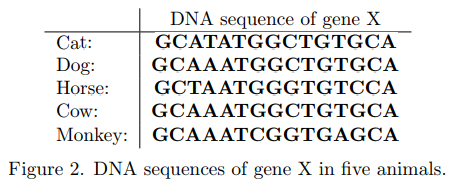题目(中英对照):
-
DNA (Deoxyribonucleic Acid) is the molecule which contains the genetic instructions. It consists of four different nucleotides, namely Adenine, Thymine, Guanine, and Cytosine as shown in Figure 1. If we represent a nucleotide by its initial character, a DNA strand can be regarded as a long string (sequence of characters) consisting of the four characters A, T, G, and C. For example, assume we are given some part of a DNA strand which is composed of the following sequence of nucleotides:
-
DNA(脱氧核糖核酸)是含有遗传指令的分子。 它由四种不同组成核苷酸,即腺嘌呤,胸腺嘧啶,鸟嘌呤和胞嘧啶,如图1所示。如果我们代表核苷酸在它的初始特征中,DNA链可以被视为由四个字符A,T,G和C组成的长字符串(字符序列)。例如,假设我们给出了由DNA组成的一部分DNA链。 以下核苷酸序列:

-
“Thymine-Adenine-Adenine-Cytosine-Thymine-Guanine-Cytosine0-Cytosine-Guanine-Adenine-Thymine”
-
T-A-A-C-T-G-C-C-G-A-T
-
Then we can represent the above DNA strand with the string “TAACTGCCGAT.”
-
然后我们可以用字符串“TAACTGCCGAT”表示上面的DNA链。
-
The biologist Prof. Ahn found that a gene X commonly exists in the DNA strands of five different kinds of animals, namely dogs, cats, horses, cows, and monkeys. He also discovered that the DNA sequences of the gene X from each animal were very alike. See Figure 2.
-
生物学家Ahn教授发现,基因X通常存在于五种不同动物的DNA链中,即狗,猫,马,牛和猴。 他还发现每只动物的基因X的DNA序列非常相似。 见图2。

-
The Hamming distance is the number of different characters at each position from two strings of equal length. For example, assume we are given the two strings “AGCAT” and “GGAAT.” The Hamming distance of these two strings is 2 because the 1st and the 3rd characters of the two strings are different. Using the Hamming distance, we can define a representative string for a set of multiple strings of equal length. Given a set of strings S = {s1, . . . , sm} of length n, the consensus error between a string y of length n and the set S is the sum of the Hamming distances between y and each si in S. If the consensus error between y and S is the minimum among all possible strings y of length n, y is called a consensus string of S. For example, given the three strings “AGCAT” “AGACT” and “GGAAT” the consensus string of the given strings is “AGAAT” because the sum of the Hamming distances between “AGAAT” and the three strings is 3 which is minimal. (In this case, the consensus string is unique, but in general, there can be more than one consensus string.) We use the consensus string as a representative of the DNA sequence. For the example of Figure 2 above, a consensus string of gene X is “GCAAATGGCTGTGCA” and the consensus error is 7.
-
汉明距离是两个相等长度的弦在每个位置的不同字符的数量。例如,假设我们给出两个字符串“AGCAT”和“GGAAT”。这两个字符串的汉明距离是2,因为两个字符串的第1个和第3个字符是不同的。使用汉明距离,我们可以为一组长度相等的多个字符串定义代表性字符串。给定一组字符串S = {s1, . . . , sm}长度为n的字符串y,长度为n的字符串y和集合S之间的共识误差是y与S中每个si之间的汉明距离之和。如果y和S之间的共识误差是所有可能的最小值长度为n的字符串y,y称为S的共识字符串。例如,给定三个字符串“AGCAT”“AGACT”和“GGAAT”,给定字符串的一致字符串是“AGAAT”,因为汉明距离的总和在“AGAAT”和三个字符串之间是3,这是最小的。 (在这种情况下,共识字符串是唯一的,但一般来说,可能存在多个共有字符串。)我们使用共识字符串作为DNA序列的代表。对于上面图2的例子,基因X的共有字符是“GCAAATGGCTGTGCA”,共识错误是7。
输入格式:
-
Your program is to read from standard input. The input consists of T test cases. The number of test cases T is given in the first line of the input. Each test case starts with a line containing two integers m and n which are separated by a single space. The integer m (4 ≤ m ≤ 50) represents the number of DNA sequences and n (4 ≤ n ≤ 1000) represents the length of the DNA sequences, respectively. In each of the next m lines, each DNA sequence is given.
-
您的程序是从标准输入读取。 输入由T个测试用例组成。 测试用例T的数量在输入的第一行给出。 每个测试用例以包含两个整数m和n的行开始,这两个整数由一个空格分隔。 整数m(4 ≤ m ≤ 50)表示DNA序列的数目,n(4≤n≤1000)分别表示DNA序列的长度。 在接下来的m行中的每一行中,给出每个DNA序列。
输出格式:
-
Your program is to write to standard output. Print the consensus string in the first line of each case and the consensus error in the second line of each case. If there exists more than one consensus string, print the lexicographically smallest consensus string
-
你的程序是写入标准输出。 在每个案例的第一行打印共识字符串,在每个案例的第二行打印共识错误。 如果存在多个共识字符串,则打印按字典顺序排列的最小共识字符串
输入样例:
3
5 8
TATGATAC
TAAGCTAC
AAAGATCC
TGAGATAC
TAAGATGT
4 10
ACGTACGTAC
CCGTACGTAG
GCGTACGTAT
TCGTACGTAA
6 10
ATGTTACCAT
AAGTTACGAT
AACAAAGCAA
AAGTTACCTT
AAGTTACCAA
TACTTACCAA
输出样例:
TAAGATAC
7
ACGTACGTAA
6
AAGTTACCAA
12